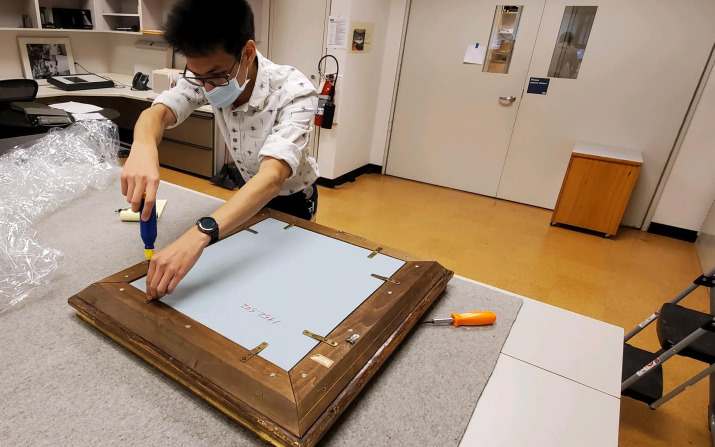Winston Kam interns at Cleveland Museum of Art

A double major in Materials Science and Engineering and Art History, Winston Kam spent his summer at the Cleveland Museum of Art bringing his two passions together as a conservation frame intern.
Despite his love of art and skills in the sciences, Kam was originally intimidated by the level of artistic knowledge and chemistry knowledge necessary for a career in art conservation. However, speaking with conservators at the museum and with graduate students pursuing such a career made him realize his potential. “Art has always been something I love and cherish so being able to combine STEM into prolonging its existence, not just for aesthetics but for the purposes of cultural heritage, is so important for our understanding of the past,” he said.
Kam’s main focus as an intern was creating newly gilded replacement liners for three of the museum’s artworks: Young Woman with a Turban by Jacques-Louis David, The Houses of Parliament from Westminster Bridge by Andre Derain and Wrestlers in a Circus by Ernst Ludwig Kirchner. A smaller frame that fits inside a larger one, the purpose of a liner is to serve as a transition layer between the painting and the frame. Kam described liners as “disregarded yet essential” due to the fact that they are not an original combination to the painting, pointing out that little work is often done on the liner. If a curator thinks that a liner could distract a viewer if it doesn’t look right, they request a replacement. His primary duties included sanding down layers of gesso, laying gold, or toning the liners.
Despite the COVID-19 pandemic, Kam spent all his internship time in the museum’s conservation labs and felt “very fortunate” to be able to do so. Museum employees were required to wear masks at all times. “When we had our department picnic during my last week at Horseshoe Lake Park it was shocking to see my co-workers’ faces for the first time after working with them all summer,” he said.
Art museums typically split conservation departments into different labs, and in Cleveland, there are nine. Some prominent ones include paintings; three-dimensional objects; paper, photographs and prints; textiles; and East Asian paintings. Each lab has its own way of preserving its artwork and Kam pointed out that it takes “years and years” to understand the infinite ways for conserving that medium. For example, object conservators who maintain outdoor sculptures like The Thinker on the museum’s south lawn need strong knowledge of bronze casting and patinas, while paintings conservators can use SEM or EDS to find a work’s geographic origin or understand the elemental composition.
Kam believes the connections he made this summer in the field of conservation will help him with his goal of pursuing a career in art conservation. “The rigor and competitiveness to get into 1 of the 5 conservation graduate programs in North America are unmatched compared to any other academic field of study,” he said. “Almost all programs require at least two years of chemistry and labs, studio art experience, an outstanding portfolio, and internship experience prior to applying.”
Even after his internship, Kam plans to stay involved with the museum’s conservation labs. Several conservators approached him about creep testing on the museum’s Krishna statue and researching the off-gas of various 3D printed materials when situated next to artworks in sealed plexiglass housings. Kam also hopes to conduct light conservation work on the Putnam Sculpture Collection, particularly Spitball by Tony Smith on the quad. Overall, Kam hopes to help strengthen the relationship between CWRU’s STEM departments and the museum, pointing out the potential for collaboration on conservation projects.
Kam often spent his lunch breaks browsing the galleries at the museum and looks forward to spending more time there once classes resume. He wrapped up his summer by creating a video presentation of his time as an intern.
